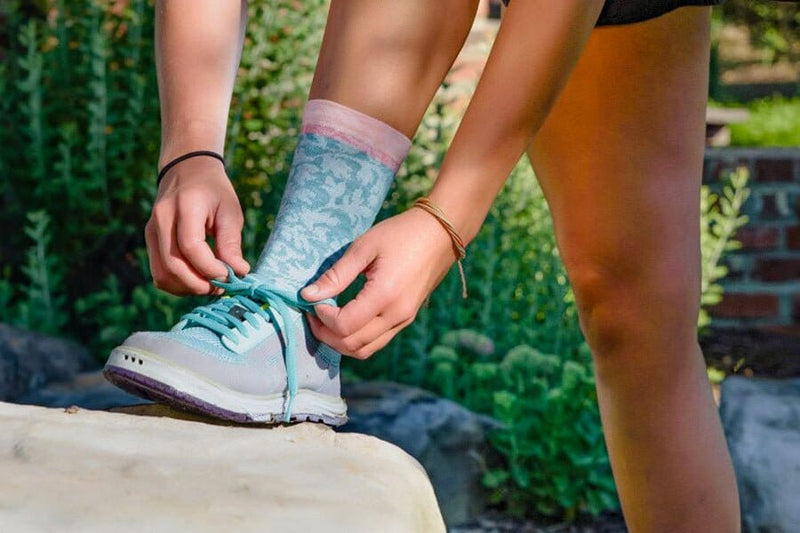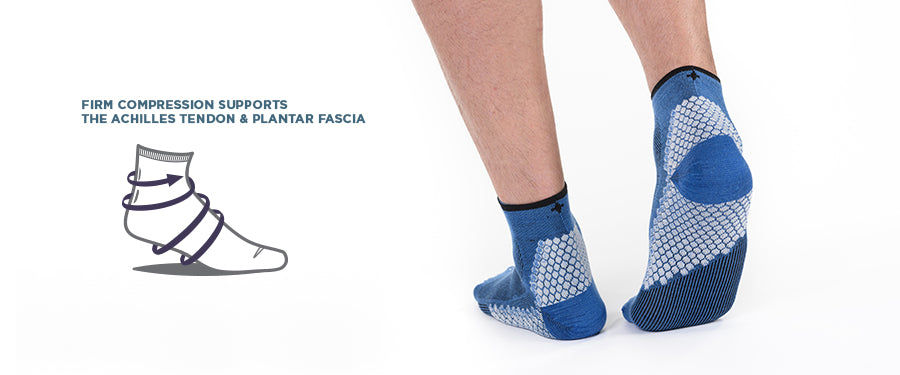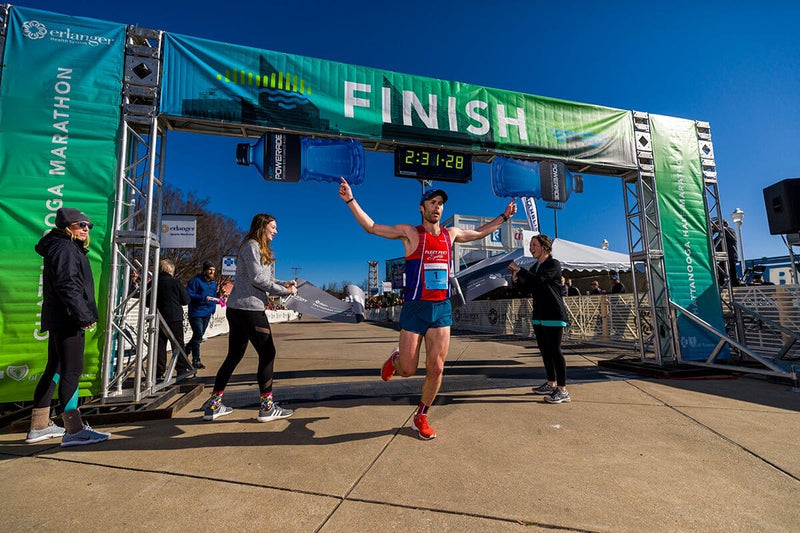
You wake to your alarm, the sun through your bedroom windows. A brand new day. You swing out of bed, plant your feet to stand up, and a sudden stabbing pain near your heel convinces you to sit back down.
Runners know it all too well. Hikers have hobbled the last few miles to the trailhead because of it. In fact, researchers at Harvard found that it’s one of the most common reasons for heel and foot pain among adults.
Plantar Fasciitis. The inflammation of the thick band of tissue (called the fascia) at the bottom of your foot that runs from your heel to your toes and supports the arch of your foot.
It occurs when the plantar fascia is overstretched, creating small tears in the fascia, particularly where the fascia meets the heel bone. Commonly recognized as a stabbing pain, plantar fasciitis is typically felt in the morning when you take your first steps of the day and as you move, the pain subsides. This bottom foot pain can also be triggered after long periods of standing or when you get up after sitting. (Mayo Clinic)
If you’re wondering how to heal from plantar fasciitis quickly, it starts with protecting and comforting your feet. For many, identifying risk factors that may affect you, making modest adjustments to your lifestyle, and investing plantar fasciitis relief socks are among the proactive steps you can take towards your journey to Feel Better in Style.
Causes & Factors
 Simply put, plantar fasciitis occurs when the plantar fascia absorbs too much tension causing small tears in the fascia. Since the fascia is there to support and absorb the shock and impact to your foot, tearing and inflammation of the fascia sends a pain signal straight from your foot to your brain. While the exact causes remain unclear, there are several risk factors to consider.
Simply put, plantar fasciitis occurs when the plantar fascia absorbs too much tension causing small tears in the fascia. Since the fascia is there to support and absorb the shock and impact to your foot, tearing and inflammation of the fascia sends a pain signal straight from your foot to your brain. While the exact causes remain unclear, there are several risk factors to consider.
Risk Factors
- Type of exercise. Exercises that place a lot of stress on your heel and the attached tissue, such as long-distance running, aerobic dancing, and other forms of high impact exercise can impact the overall health of the plantar fascia.
- Prolonged standing. Those who hold occupations that keep you on your feet—like teachers, nurses, and factory workers—may also be at risk. Long periods of time standing on hard surfaces puts stress on the plantar fascia.
- Tight, weak, or compromised Achilles tendon. The plantar fascia and Achilles tendon work together to provide support and movement through the foot and ankle. If your Achilles tendon is inflamed or unhealthy, this puts additional stress on the plantar fascia to support your foot and ankle as you stand and move about.
- Your foot’s shape & how you walk. If you have flat feet or a high arch, it can cause weight and shock to be distributed less effectively across your foot, putting extra stress on the plantar fascia. Even abnormal walking patterns, like walking with an abnormal gait, can add stress.
- Weight. The more weight you carry, the more support you need from your feet. Extra pounds can create additional stress on the fascia.
You may be able to chalk up your morning pain to the common aches of a great workout from the previous day. But if you suspect it may be more than common soreness, we encourage you to try the home therapies below. If you are experiencing severe pain, consult your doctor immediately. Ignoring plantar fasciitis could result in chronic pain.
Home Therapies for Plantar Fasciitis Pain
The good news is there are several things you can do at home help with plantar fasciitis pain, and allow you to heal from plantar fasciitis quickly. In a study of heel pain by Harvard Health Publishing, approximately 90% of people with plantar fasciitis heal within 6 to 8 weeks by using conservative, nonsurgical therapy. Moreover, less than 5% require surgery.
Reevaluate your shoe selection. You put time into selecting the right shoe for an important meeting or big night out, so why not put the time in when it comes to choosing your more common everyday wear? Look for shoes with:- A low to moderate heel
- Good arch support
- Thick soles
- Extra cushioning
No shoes? No problem! Wear a supportive sock. Nothing feels more freeing than flinging off your shoes after a long day's work. You may even have the option to work from home, allowing your feet to roam free the majority of the day. However, it’s recommended not to walk barefooted.
Consider donning a pair of therapeutic socks that help to support and comfort your feet by providing firm support to both the plantar fascia and Achilles tendon. Our Plantar Fasciitis Relief socks have firm compression around the arch to help absorb stress that's often passed fully onto the fascia, allowing you to remain comfortably on and off your feet all day. This compression also helps energize your feet by reducing swelling and minimizing discomfort.
Stretch. Stretch. Stretch. Like any muscle or tendon, a daily stretch for your plantar fascia, Achilles tendons, and calves can do wonders, especially as you start your day or warm up for a workout. Try these plantar fasciitis stretches for general foot health.
Stretch your plantar fascia and Achilles tendon with three seated exercises. Start out seated in a chair with your back straight.- Exercise 1: Roll your foot over a small foam roller, lacrosse ball, or other cylindrical object for one minute on each foot.
- Exercise 2: Cross one leg over the other, grab your big toe and gently pull it towards you holding for 15 to 30 seconds. Do this big toe stretch a few times on each foot.
- Exercise 3: Roll a towel to form an exercise strap and place it under the arch of one foot, grabbing each end of the towel with both hands. Gently pull the top of your foot toward you, hold for 15 to 30 seconds, and repeat a few times on each foot.
Work towards a healthy weight. If you suspect extra weight to be the culprit of plantar fasciitis problems, work towards a healthy weight and try to sustain it. Low impact exercises such as swimming or bicycling are great ways to get your sweat on without further contributing to your pain.
These home therapies, when used early and frequently, help promote healing—and ideally help you avoid more invasive treatments such as injections or surgery.
However, you know your body best. If your plantar fasciitis is severe, and the use of these home therapies and plantar fasciitis socks don’t provide relief, consult your doctor on the best treatment for you.
Feel Better in Sockwell Plantar Fasciitis Socks

As a company, we believe home is where the healing starts. While there’s no silver bullet to curing plantar fasciitis, what you put on your feet is just as important as the path you place them on.
Our socks are made with homegrown merino wool blend yarns, which helps to regulate temperature and keep your feet dry, making them comfortable to wear all day long. Good foot health is important when helping to care for your plantar fascia and Achilles tendon.
When you purchase a pair of Sockwell Plantar Fasciitis Relief Socks, you can expect all-day comfort combined with firm support of your plantar fascia and Achilles tendon—the perfect pairing. You’ll get the benefits of:
- Plantar, arch, and ankle support
- Firm compression
- Varying levels of cushioning
- Options include quarter and crew socks, and sleeves
Soothe. Relieve. Protect. Shop Sockwell Plantar Fasciitis Relief Socks and Sleeves.



